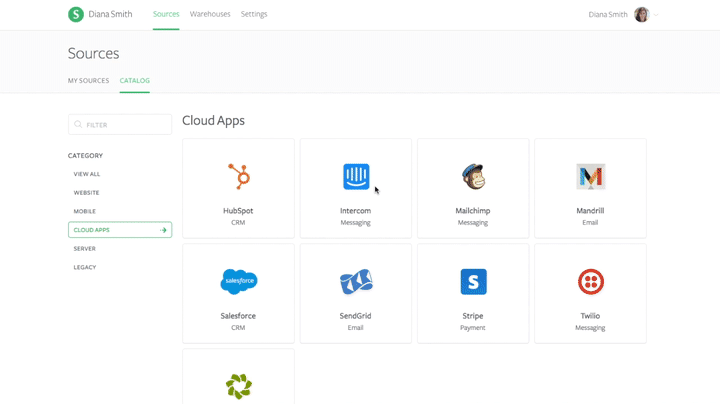Segment is an increasingly popular customer data aggregator that makes it easy for engineers to track funnel events, test new analytics partners, and combine data collected from websites, mobile apps, and servers. In a marketing technology universe littered with customer data tools, this can be really useful. At VB Insight, I studied the marketing analytics landscape and counted 700+ tools marketers use to house customer data and generate marketing insights. I didn’t collect all of them, and Segment doesn’t integrate with nearly all of them. Even still, in the classic “build vs. buy” dialectic — which was alive and well at VentureBeat’s own Mobile Summit this past week — Segment has historically offered the compelling alternative of “try.”
The new release, called Sources, is potentially much more powerful than that.
While web and mobile app data can be a massive undertaking unto itself, what about the droves of data collected in email campaigns, customer support channels, or payment systems? After all, customers don’t just use websites and mobile apps. They open emails, have conversations with salespeople, chat with customer support, and pay for stuff. These data sources typically live in their own silo — and in large, oftentimes fragmented companies, they are managed by their own engineering team with their own release and update cycles and data analysts.
In this model, tons of data gets left behind. And even in digitally mature companies thoroughly invested in customer analytics, they still have a hard time combining data sources with third-party systems — like contact center or payment information — and making it mean something.
Segment’s new offering is interesting because it’s drawing from rather than sending to cloud providers like Salesforce, Zendesk, Stripe, SendGrid, Mandrill, and Twilio, pulling information into a single database with just a few clicks. I usually scoff at the “5 mins to install, no engineering time required” vendor speak — but in Segment’s case, it’s actually true.

More importantly, with all of this actual customer data in one place, companies can finally understand the complete customer experience and explore how touchpoints across communication channels affect revenue, engagement, retention, and churn. It allows engineering and marketing teams to stop focusing so much on data collection and start thinking about the customers behind the data. I like to use the analogy of water at a well. Are your highly paid data analysts best used pumping a cistern or gathering water? Or would be they be more effective with an effective infrastructure in place, building cool irrigation apps with that water system to make your products grow? With sources, Segment customers can truly focus on growth initiatives. For instance, they can see which pages in an app prompt the most support tickets, or whether customers opting in via text are more engaged than those in email, or even how support tickets can drive purchases.
Trunk Club, Instacart, Mapbox, Udacity, 99Designs, and Angie’s List are some of the launch customers using Sources and spending less time gathering water. Combining data this way puts typically near-impossible tasks, like quantifying the value of customer support — or understanding the effects of email and text message campaigns over time — very reachable, if not downright testable.
I also caught up with Segment CEO Peter Reinhardt to learn a little more about what the release means for high-performing teams and what’s possible with all of this disparate third party data living in one place. Perhaps, most importantly, are the types of sources available on the product now and on the way. Reinhardt said, in an email, “We have 8 sources to start (Salesforce, Stripe, Zendesk, SendGrid, Mandrill, Intercom, Hubspot, and Twilio) with 2 more currently in beta (Mailchimp, SalesforceIQ). We’re planning to significantly increase the sources catalog in the coming months. The new categories we’ll start with include advertising (Google Adwords, Facebook Ads) and databases (MongoDB, Postgres).”
Segment has also seen significant growth over the past year. Reinhardt told me, “Sources builds on our considerable momentum over the last year, which includes the launch of new products like Warehouses, a Series B led by Thrive Capital, and an increase in headcount from 30 to 80.”


